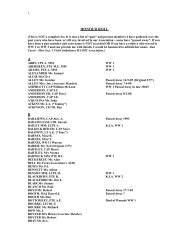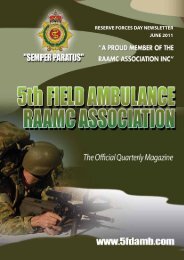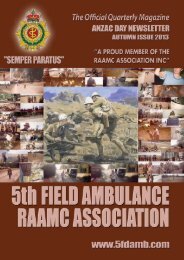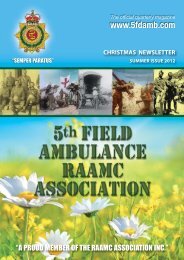2010 Paulatim Magazine - RAAMC Association
2010 Paulatim Magazine - RAAMC Association
2010 Paulatim Magazine - RAAMC Association
Create successful ePaper yourself
Turn your PDF publications into a flip-book with our unique Google optimized e-Paper software.
Some of these differences change over time presenting challenges to<br />
each of us. Greater troop dispersion and improved lethality of weapons<br />
in the modern battlefield implies we will need to apply greater tactical<br />
understanding and more technical expertise to accurately support and<br />
coordinate the health effort. Yet we focus on improving clinical improve<br />
skills of our military health staff. To ensure health planning, military<br />
health staff will need to have better contact with the whole Battle<br />
Group. That is better communication, and manoeuvre and application of<br />
military health skills.<br />
Another constant challenge is the expectation that care for casualties<br />
will be based on optimal, comparable civilian levels of medical care<br />
creates a tension. The civilian sector faces fundamental change and<br />
uncertainty greater than our own. Health accounts for a significant<br />
proportion of government expenditure. History dictates expenditure on<br />
health continually rises due to dependency and demand. In this<br />
environment, earlier intervention and prevention has lead to shorter<br />
periods of hospitalisation, better health, and longer life. This can only<br />
work if health care assets are structured to achieve a common outcome,<br />
even if they are in competition with each other.<br />
Comparable levels of civilian care can be based on a military health<br />
chain of care. This can be replicated within the ADF through adaptation<br />
of the existing framework. A joint approach to health starts with<br />
Prevention (physical conditioning, diet, environmental health and<br />
health intelligence), where prevention fails emergency procedures<br />
(casualty evacuation and medical regulation) stabilise life and deliver<br />
the casualty to the most appropriate treatment facility. Treatment can<br />
be provided to save life and promote functioning and assist healing<br />
(role 1 – 3 medical support), prior to rehabilitation (physical<br />
conditioning and ongoing support) and return to duty or discharge.<br />
Every military health professional should be able to explain each to our<br />
colleagues and prospective patients.<br />
One way to minimise the tension and challenges is to reduce<br />
unnecessary duplication of services. At present considerable expertise is<br />
“tied up” in a few senior people, a lack of knowledge then emerges at<br />
the tactical and operational health planning making determination of<br />
strategic and future capability difficult. A step towards jointery has<br />
occurred with ADF health refocussed under a central command with<br />
regional delivery. This spoke and hub model of health care has<br />
provided small well-coordinated health units responsible for the Land,<br />
Air and Maritime Health delivery. We have generated an independent<br />
chain of care for our patients providing a seamless transition of patient<br />
management from point of injury overseas and returning to<br />
comparable levels of treatment in Australia. Yet we cannot remove that<br />
fact that health is an emotive issue resulting in a perception of military<br />
health support being sub-optimal against civilian levels of care.<br />
One way to reduce further tension is through the delivery of numerous<br />
joint health projects. These are highlighted and summarised below:<br />
• JP 2048 the amphibious ship brings larger joint health capability.<br />
The Primary Casualty Reception Facility provides a that can grow<br />
from a complement of 25 staff to a 75 staff facility with:<br />
°<br />
°<br />
°<br />
°<br />
°<br />
6 resuscitation bays, (TRIAGE area in the aircraft hangar);<br />
2 operating facilities (each capable of housing up to 2<br />
operating tables);<br />
2 Intensive Care beds (ICU)<br />
6 (8) HDU beds; and<br />
36 LDU beds.<br />
• JP 2060 has delivered Phase 1 and Phase 2 Deployable Health<br />
Capability (DHC) for example replacing canvas with weather-haven<br />
systems to remove duplication of single service solutions to deliver<br />
a joint operational capability. Phase 3 will provide a three tiered<br />
enhancement to our operational support including:<br />
°<br />
°<br />
°<br />
Health systems<br />
Health Training systems<br />
Health C4I<br />
These two projects will present enhancements and combined health<br />
optimisation however there are several projects including mobility<br />
platforms such as the new Army Vehicle project (overlander), Land 400<br />
(Armour replacement), enhanced tactical communications and Strategic<br />
Reform that will provide overall optimisation of ADF Health.<br />
8 8 P A U L AT I M – M A GAZINE O F T HE R OYA L A U S T R A L I A N A R M Y M E DICAL C O R P S – 2 0 1 0<br />
I challenge each of you to think of military health as restrained,<br />
conservative and inflexible. Please challenge yourself, as I believe often<br />
that you are the only limiting factor and by improving your utility in<br />
Military Health you improve the health of others.<br />
In sum, the changing face of ADF Health services has several constants,<br />
deployed health capability must provide comparable levels of civilian<br />
care to our soldiers, and every health professional has the obligation<br />
of understanding the differences of Defence health and be able to<br />
utilise them. We live in exciting times, the difference will be the way<br />
we apply it, as enhanced capability can be delivered and single service<br />
barriers dropped by enhanced jointness.<br />
By: MAJ Mike Treloar










